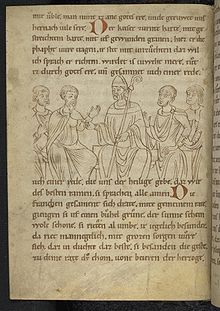Turpin of Reims

Turpin von Reims (also Tilpin ) (* before 748/751; † September 1, 794 in Reims ) was a Frankish clergyman who was the first archbishop in Reims in the second half of the 8th century . He is considered one of the most important bishops of his time. During his activity as a theologian , which lasted for over 40 years, he exercised exemplary pastoral care and was involved in reform activities. Until the 17th century he was the authorship of the Historia Karoli Magni et Rotholandi and numerous other works, which resulted in legends surrounding him. His tomb is in Reims Cathedral .
After a long vacancy, Wulfar 812 was Turpin's successor in the office of Archbishop.
Live and act
The origin of Turpin cannot be determined, but it is known that before his time as abbot in Saint-Denis near Paris he served. An epitaph written by his successor, Hinkmar , confirms that Turpin was a clergyman in Reims for about 40 years. It is believed that Turpin performed his services in Reims as choir bishop next to Bishop Milo and only held the office of archbishop after his death.
Turpin is known for his remarkable internal organization of the church and is mentioned as the founder of the Reims writing school. Turpin is also respected for his reform work, which was continued by Boniface. He was also integrated into the reorganization of the Metropolitan Constitution. He was a participant in the Roman Synod of 769, in which the basic relationship between the Pope and the Patriarch of Constantinople was discussed.
In 779, Pope Hadrian Turpin awarded the pallium to the Reims Church in a letter , which regained its status as a metropolis during his tenure. The same letter contained the order to write a canonical-dogmatic statement about the Mainz Bishop Lul . It turned out that this letter was forged or interpolated in the middle of the 9th century.
Despite the unrest and the reorganization of the church in the transition period from Merovingian to Carolingian rule, Turpin was able to secure the important position of Reims and the material basis for the church through reacquired privileges and material possessions.
Pseudo-Turpin
In the 11th century, the belief developed that Turpin was an eyewitness to the Battle of Roncesvalles in 778 and reported about it. In addition, he should talk about the liberation of the grave of St. James of the Saracens through Charlemagne . Since this work, also known as Pseudo-Turpin, was not written until the mid-12th century, Turpin is excluded from authorship and it is assumed that the author was an unknown French cleric.
literature
- Thomas Bauer: Turpin from Reims. In: Biographisch-Bibliographisches Kirchenlexikon (BBKL). Volume 12, Bautz, Herzberg 1997, ISBN 3-88309-068-9 , Sp. 727-731.
- Olaf Schneider: Archbishop Hinkmar and the consequences. The four hundred year journey of historical memories from Reims to Trier. Berlin 2010
- Klaus Herbers : Turpin (Tilpin). In: Lexikon des Mittelalters , Vol. 8 (1997) Sp. 1119–1120.
Individual evidence
- ↑ Thomas Bauer: Turpin of Reims. In: Biographisch-Bibliographisches Kirchenlexikon (BBKL). Volume 12, Bautz, Herzberg 1997, ISBN 3-88309-068-9 , Sp. 727-731.
- ↑ Thomas Bauer: Turpin of Reims. In: Biographisch-Bibliographisches Kirchenlexikon (BBKL). Volume 12, Bautz, Herzberg 1997, ISBN 3-88309-068-9 , Sp. 728.
- ↑ Thomas Bauer: Turpin of Reims. In: Biographisch-Bibliographisches Kirchenlexikon (BBKL). Volume 12, Bautz, Herzberg 1997, ISBN 3-88309-068-9 , Sp. 728.
- ↑ Olaf Schneider: Archbishop Hinkmar and the consequences. The four hundred year journey of historical memories from Reims to Trier. Berlin 2010, pp. 80–81.
- ↑ Thomas Bauer: Turpin of Reims. In: Biographisch-Bibliographisches Kirchenlexikon (BBKL). Volume 12, Bautz, Herzberg 1997, ISBN 3-88309-068-9 , Sp. 730-731.
| predecessor | Office | successor |
|---|---|---|
| Abel |
Archbishop of Reims 748–794 |
Wulfar |
| personal data | |
|---|---|
| SURNAME | Turpin of Reims |
| ALTERNATIVE NAMES | Tilpin |
| BRIEF DESCRIPTION | Archbishop of Reims |
| DATE OF BIRTH | before 751 |
| DATE OF DEATH | September 1, 794 |
| Place of death | Reims |
